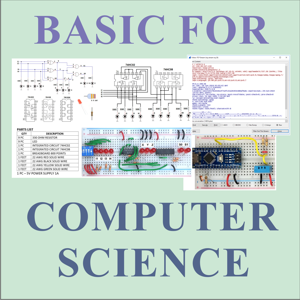描述
The purpose of this material is to present in an integrated way the basic knowledge in the key areas of Computer Science. Knowledge of mathematics and physics, particularly in electricity, equivalent to level 9 of the k12 curriculum is required. Tests are available in the area of Computer Systems, Networks and Internet and Small Basic Programming. The Data Structure and Computing Impacts modules are practical and have no tests. The material presents a structured and interrelated view between all these fields in the creation of devices and programs related to computing. The area is extensive and complex. It may not be possible to study all subjects in the school year. So, the suggestion is to divide the class into 5 groups, each group specializing in one of the areas. Each group can then prepare a short lesson on their area and present a lesson to the remaining groups. Each area has some classes that must be studied in depth and other classes that serve as reference material when necessary. The Computer Impacts chapter integrates Small Basic and some digital devices with Arduino. Thus, it is possible to have a global perspective of Computer Science and realize that several techniques, from hardware to software, are integrated into the computational devices that we use in our daily lives. Much of this work is already contained in the Computer Systems One, Computer Networks One, Programming Small Basic and Computer Database SQLite applications. The Computing Impacts module is completely new. Anyone who wants to learn and experiment more with Arduino can use the Arduino Computer Science application.
STUDY MATERIAL – 565 PAGES, 41 CODES AND 260 TESTS MODULE DIGITAL SYSTEMS – 123 PAGES AND 100 TESTS > LESSON 1 – FUNDAMENTALS OF DIGITAL SYSTEMS – 30 PAGES > LESSON 2 – DIGITAL CIRCUITS – 23 PAGES AND 3 EXPERIMENTS > LESSON 3 - COMPUTERS – 33 PAGES > LESSON 4 – MEMORY, INPUTS, OUTPUTS AND FILES – 37 PAGES MODULE NETWORKS AND INTERNET – 124 PAGES AND 80 TESTS > LESSON 1 – OSI MODEL – PHYSICAL AND DATA LINK LAYERS – 30 PAGES > LESSON 2 – NETWORK AND TRANSPORT LAYERS – 38 PAGES > LESSON 3 – WIFI PROTOCOL – 36 PAGES > LESSON 4 – WIRESHARK, FIREWALL AND INTERNET OF THINGS – 20 PAGES MODULE SMALL BASIC PROGRAMMING –121 PAGES, 17 CODES AND 80 TESTS > LESSON 1 – SMALL BASIC FUNDAMENTALS – 30 PAGES AND 7 CODES > LESSON 2 – PROGRAMMING WITH SMALL BASIC – 32 PAGES AND 5 CODES > LESSON 3 – TEXT AND GRAPHICS WINDOW COMMANDS – 28 PAGES AND 3 CODES > LESSON 4 – FILES AND OTHER COMMANDS – 20 PAGES AND 2 CODES MODULE DATABASE SQLITE WITH SMALL BASIC – 118 PAGES AND 14 CODES > LESSON 1 – KNOWING DATABASE MANAGER – 32 PAGES > LESSON 2 – HOW TO USE A DATABASE WITH SMALL BASIC – 30 PAGES AND 5 CODES > LESSON 3 – OPERATIONS WITH RECORDS – 25 PAGES AND 3 CODES > LESSON 4 – SQL SENTENCES – 31 PAGES AND 6 CODES MODULE ARDUINO AND SMALL BASIC PROJECT – 90 PAGES AND 10 CODES > LESSON 1 – ARDUINO NANO – 38 PAGES > LESSON 2 - SENSORS – 28 PAGES AND 4 CODES > LESSON 3 – ARDUINO AND SMALL BASIC – 24 PAGES AND 6 CODES
COMPUTER SCIENCE LEVEL 9 The various tutorials present the subjects listed below in a practical way through real examples. It also analyzes issues in an interdisciplinary manner. These apps are available from the Windows Store. COMPUTER SYSTEMS ONE – history, bit and byte, arithmetic operations, logical operations, combinatory logic, clock, flip-flop, computer hardware, assembly language and computer files. Tests - 100 questions by topic, 20 questions randomly select and 40 questions randomly selected. COMPUTER NETWORKS ONE – OSI model, physical layer, data link layer, network layer, transport layer, wireless network, network layer services, transport layer services, Wireshark and Firewall. Tests - 80 questions by topic, 20 questions randomly select and 40 questions randomly selected. COMPUTER DATABASE SQLITE – history, database project, creating a database, inserting data, optimizing the code, updating data records, inserting and deleting, show records, SQL commands and data structure. PROGRAMING SMALL BASIC – installing Small Basic, algorithms and programming, variables and operators, statements, turtle – comparing with Scratch, text window and text commands, graphics window commands, file commands, other commands. Tests - 80 questions by topic, 20 questions randomly select and 40 questions randomly selected. BASIC FOR COMPUTER SCIENCE – LEVEL 9 ARDUINO FOR COMPUTER SCIENCE – LEVEL 10 By 2021 – RASPBERRY FOR COMPUTER SCIENCE – LEVEL 11


